Turquoise
Energy Ltd. News #100
covering May 2016 (posted June 3rd 2016)
Victoria BC
by Craig Carmichael
www.TurquoiseEnergy.com
= www.ElectricCaik.com
= www.ElectricHubcap.com
= www.ElectricWeel.com
Features:
* Planetary Gear Variable Torque Converter is The Ultimate
Automotive Transmission! (see Month in Brief, Electric Transport)
* Permian Period Revisited: The Age of Evolving Amphibians, not
Reptiles (Special report)
Month In Brief
(Project Summaries)
- Variable Torque Converter Transmission... & crab fishing -
Permian Period Revisited - Commercializations?
In Passing
(Miscellaneous topics, editorial comments & opinionated rants)
- Mexican Silver Money - Financial Collapse Timeline?
- In Depth
Project Reports -
Permian Period Revisited: The Age of Evolving
Amphibians, not Reptiles
Electric
Transport - Electric Hubcap Motor Systems
* Electric Hubcap motor, Chevy Sprint & Variable Transmission -
Conclusion: PGTC looks like the ultimate auto tranny, May's
frustrations solved... I think - miswired phases - better planetary
gear?... buy it! - Stronger Spring - Various experiments and
adjustments with springs and mountings
* A small note on permanent magnet assisted motors: just by luck I made
the ARM motor that can be converted
Other "Green"
Electric Equipment Projects (no reports)
Electricity Generation (no reports)
Electricity Storage - Turquoise Battery
Project (NiMn, NiNi, O2-Ni), etc.
-
Source of Electrolyte - Oxidizing Graphite for the Positrode - Nickel
Ion Battery: another form of nickel-nickel cell
No Project Reports on: I'm
dropping this section. In theory I've felt it's good to be able to see
quickly if there's been no activity in an area of interest rather than
to have to read through to find it's not there by omission, but it's
probably more confusing than anything... especially to me to decide
what to include as projects and project ideas evolve and morf. I now
put what is covered in "Month in Brief" in the contents under that
heading, so if something is even briefly written about anywhere it'll
appear somewhere in the contents above.
May in Brief
My work at AGO continued to eat into project time until I
finished the jobs
in mid May.
Planetary Gear Variable Torque Converter (PGTC) Transmission in
Chevy Sprint
Other than that I persevered rather doggedly with the
frustrating Sprint Car transmission project. It soon became evident
that the PGTC system actually worked just fine from a stop. Nothing
else is needed to get the car rolling, and the 'final drive ratio' to
the wheels following the converter is almost irrelevant.
What was relevant, the missing point I finally figured out
about the end of the month, is that the maximum torque out is dependent
on the maximum speed of the slipping gear, so with a lower PRM motor,
getting the most is dependent on configuring it with the slipping gear
as the fastest turning gear. Instead I had the motor on the fastest
gear, so everything else ran more slowly, and the torque conversion was
at a disadvantage. As configured it's a demo.
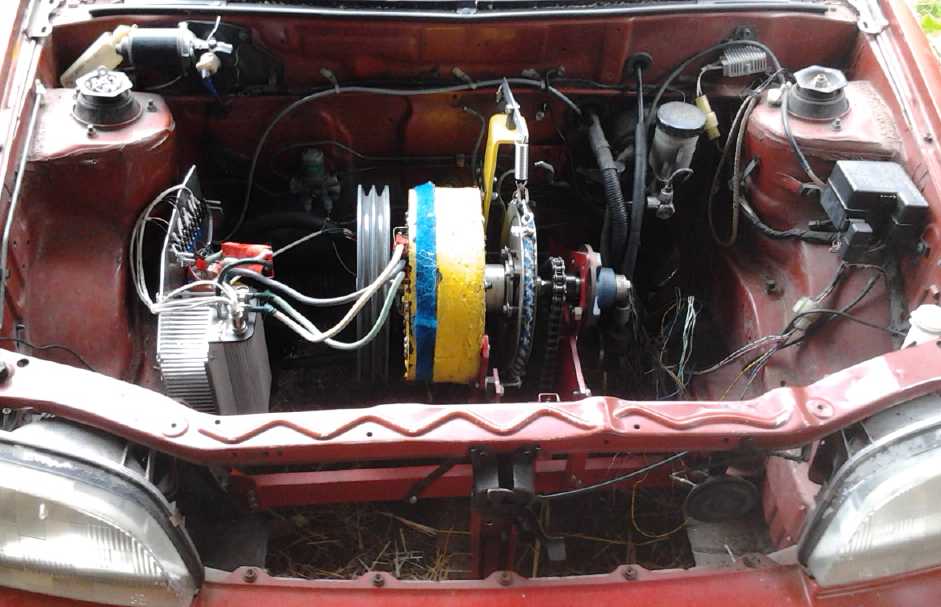 Sprint with torque converter et al. New is the
mounting bracket and lever
Sprint with torque converter et al. New is the
mounting bracket and lever
for the tensioning cable to better pull the tensioning rope.
Newly realized is that for maximum torque, the slipping pulley with the
rope should
be on the sun gear instead of the planets assembly, to turn at a higher
speed.
Until then it was a perplexing mystery why the car worked
fabulously at lower torques, but simply seemed to jam up with friction
on higher ones - if it needed more than about 20 foot-pounds of torque
at the mechanism's output shaft. That meant it wouldn't climb hills and
couldn't be taken out on the road.
I thought it seemed perhaps to have something to do with
the spring in the tensioning system. By the 17th I had a stronger
spring and was ready to install it.
But just before I
started working I was invited to go crab fishing. Here on the coast
that might be a valuable life skill at some point if food gets scarce,
so that day I bought a "clamshell" crab trap (16$ at 'Capital Iron' in
Sydney) and a fishing license and learned how to fish for
and identify crabs. I caught the allowed limit of 4 male
rock crabs off a wharf. In fact, we continued fishing and I threw the
two smallest ones back and kept two larger ones. (Grab them by the rear
legs so they can't pinch your fingers with their claws. I'm sure that
would really hurt.)
With the new spring it seemed to work a little better.
Then I made a 'proper' mounting for the slipping gear pulley tensioning
system. It still did up to 20 foot-pounds very smoothly, but still
jammed above that. I ran the car a couple or a few times most days and
scratched my head over the problem. What, what, could be wrong?
On the 25th I discovered that the pulley was being pulled
off-center by the tensioning rope, and I thought for a while that that
was the main problem. Perhaps at higher torques perhaps it was more or
less jamming the gears together, creating high friction.
But in looking for a more suitable commercially made
planetary gear and thinking of how to configure it on the 31st, I
finally realized what I believe is the actual problem. A certain amount
of torque slips the slipping gear, depending on rope tension. The
torque available at the output isn't infinite. It depends on the
slipping torque times the relative gear ratios of the slipping gear and
the output gear. The motor only runs so fast, so the slipping gear only
turns so fast, and at top speed, only 20 foot-pounds is available at
the output. More tension only slows down the motor and hence the
slipping gear without increasing the available torque, so if that same
torque won't budge the car, everything grinds to a halt. The means to
increase torque then is either to have a faster motor, or to have
higher intrinsic gear ratios, even tho any ratio above the fixed ratio
can theoretically be obtained. If the sun gear was the slipping gear,
the pulley would spin much faster and it would probably work up to a
much higher torque.
Apparently that has been the main problem with the
Planetary Gear Torque Converter (PGTC) since I first made it in 2012.
Why didn't I try other configurations earlier? It will be darned hard
to change it - a complete rebuild. I may set it up using the best
planetary gear I can find, with CNC waterjet cut metal chassis parts.
Assuming it works the experiment would double as the first pass at a
production design.
Then I started to think that with the slipping (sun) gear
shaft sticking out one end and the motor (planets) shaft sticking out
the other, and the ring gear in the middle with the chain drive
sprocket (or the original gear) to the differential, I might be able to
use the original transmission chassis, hacking it as required and
replacing all the crap inside with a single planetary gear. Then it
would be sealed to have gear oil and so solve the gear and chain
lubrication problems, keep the dust out, and it would fit some of the
original mountings.
When the torque has been within limits, I've now seen what
an amazingly smooth running variable system it can be. I think it'll be
"the ultimate auto transmission" when configured properly. All that's
needed is for the gear to be configured right.
The Permian Period Revisited
Starting in April but especially for most of May I stuck
my nose into paleontology,
where I wanted to find out more about the evolutionary transition from
amphibians to reptiles. I've never felt I had much to offer on this
sort of subject before, but as I delved into it, it gradually became
clear to me that important parts of the story had become confused by
past mistakes and that the Permian virtually needed a fresh start, a
re-evaluation, to clear them away.
Until perhaps the 1960s(?) there was perhaps little
distinction in most peoples' minds or in scientific nomenclature
between what then became known as 'amphibians' and reptiles, and this
surely played its part in creating the confusion. Prior to that,
"amphibian" was purely a functional term, and otters and seals were
called amphibians because they lived in water and on land.
Small reptiles were being assumed to have existed long
before the
fossil record showed any large ones, which somehow then evolved rapidly
into many types. But there is every reason to expect that reptiles
would have become large as soon as they differentiated from amphibians.
It started to become evident that all the presumed "reptiles" up until
the very late Permian were in fact amphibians or at least
"pre-reptiles". I noted that very heavy breast bones, sternum and
clavicles, seemed to distinguish large amphibians from reptiles. This
was well supported by mentions in Wikipedia articles of 'bone
microanatomy' suggesting low metabolic rates and aquatic or amphibious
lifestyles in those very same creatures.
Wikipedia articles showing 2, 3 or 4 possible 'clade' (family tree)
diagrams for various species and families seemed to illustrate that
there is as
much speculation as relatively clear knowledge.
I started writing with
what I feel is a convincing theory about the unsuspected purpose of the
sails of Dimetrodon and Edaphosaurus (the
"parareptilian" Pelycosaurs): they added skin surface for
amphibious respiration. This evolved into a revised
(but by no means complete or definitive) version of the history of the
Permian period as a whole.
I first put it in the In
Passing section, but as I wrote more and more and added more and
more images it made the e-mail pretty large, and since many regular
readers may not be especially interested in the topic, I made it a
special project report in its own section for the web posted 'full'
version of the newsletter. [ http://www.saers.com/recorder/craig/TENewsV2/TENews100/TENews100.html
]
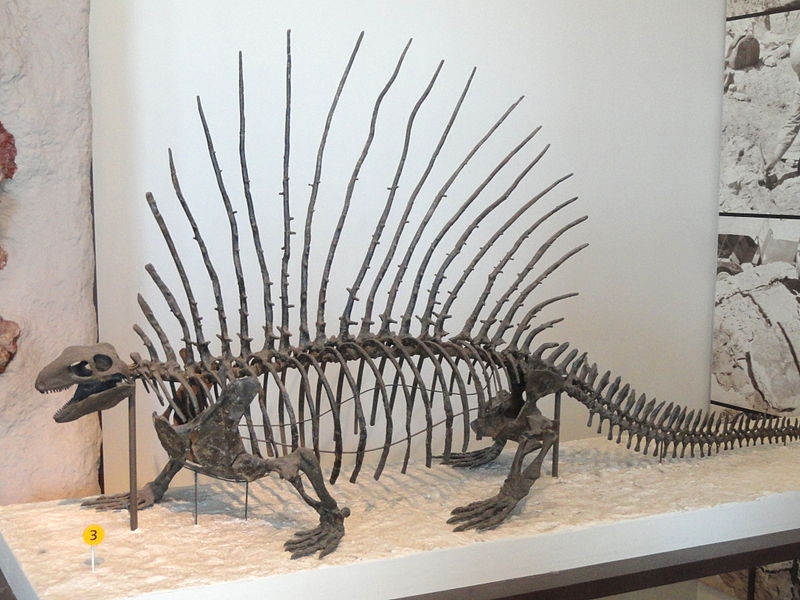 Permian Period Amphibians:
Permian Period Amphibians:
Skeleton of the Pelycosaur Edaphosaurus:
Not a "lizard" at all but a giant (~3 meters long) "salamander".
Note the heavy sternum and clavicles that anchor the buccal breathing
muscles.
The sail adds greatly to its soft, moist skin area -
skin surface is an important component of respiration in amphibians.
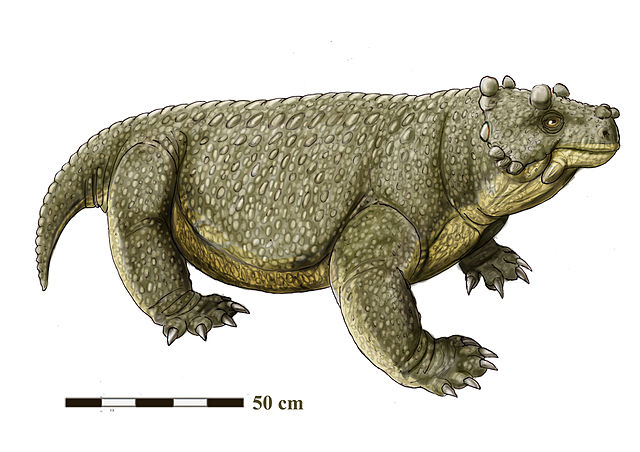 Artist's rendition of the Pareiasaur Bunostegas:
Artist's rendition of the Pareiasaur Bunostegas:
Not a "lizard" or an "ancestral turtle" after all, but rather a giant
"frog" or "toad".
With much time taken up in the first half of the month and being
determined to solve the mysteries of the PGTC in the second, I didn't
touch the 2015 tax report until the night of the 27th, when I wrote up
the points for that project. After that I continued almost daily with
some little but or other. Nor did I get any farther on the promising
nickel-air battery, the permanent magnet assisted ARM motor, or any of
the other projects.
Commercializations?
There were some indications of interest in energy
production projects, including interest from Australia in setting up an
ocean wave power system. I could see devoting time to that in some
administrative/oversight role, so long as there is development money
and I'm not the one doing the exact mechanical design drawings or much
of the fabrication or labor. It is by no means a one person project
anyway, and will have to be mostly done by paid help. Given the basic
design from the sketch in TE News #80, it becomes more a marine
engineering project than inventing. I think it should be worthwhile.
Money for employees and access to a wavy beach to build the structure
on are the key requirements, and access to power lines to send the
power to if it's to be more than an experiment or very local system. So
far I haven't even found time to send an e-mail that I probably should
have already sent.
And with a better understanding of the variable PGTC, and
seeing how smoothly it works once it's working, designs are developing
in my mind for the manufacture of PGTC transmissions for EV.s,
including under the hood types and the add-on wheel motor drive. Any
suitable motor that fits in the available space can be attached.
(allowing, eg, later upgrade to a 'permanent magnet assisted' motor)
Per the latest plans, a wheel motor would mount under the car behind
the rear wheel and connected to it by a toothed belt.
A source of funding for any or many of the projects would
help open them up. Otherwise, I think small scale PGTC transmission
manufacture might be attainable with a local partner, and I'll keep
plugging away at the rest as time permits.
In Passing
(Miscellaneous topics, editorial comments & opinionated rants)
Mexican Silver Money
Mexico mines more silver than any other country. I
recently heard that in Mexico they are using silver coins for currency.
In the USA and Canada we stopped doing that in the 1960s, as inflation
made the face value of the coins worth less than the value of the
silver they contained. (In fact, it presently costs about 15$ to buy
one dollar of face value in old Canadian silver coins - .6 troy ounces
of silver. So a dollar is worth 7% of what it was in 1967 when they
stopped putting silver in them. The other 20% was copper and maybe some
nickel to make the coin harder so it would last longer. A USA dollar
had .72 ozt as it was was 90% silver. Being the same size, the US coins
were slightly heavier overall because silver is denser than copper or
nickel.)
As I imperfectly understand it, Mexico has a new system.
The coins have a weight of silver, not a face value. Every day the
day's value of a gram of silver is posted on a government website. If
for example it was 11.35 pesos, a purchaser could go into a store and
buy a 5 peso item with a one gram sliver coin, and would receive 6.35
pesos in change. (In this system one probably sees the hand of Hugo
Salenas Price?) While fiat currency gradually inflates away, the silver
coins will retain their value. "Gresham's Law" states that bad money
drives better money out of circulation. Ie, people will spend the paper
if they have any and hang onto the silver. If Mexicans are saving in
silver, they may be better off than most of us when faith is finally
lost in fiat, as it must soon be with the lavish, unending money
printing -- first the dollar, then the yen, now the euro, next will be
the dollar again.
Financial Collapse Timeline?
Well, along with many I've been early on the collapse
timeline. Apparently some have expected it imminently even for 10 years
- and it hasn't happened yet. But Venezuela, where (in case you missed
it) people are now eating pets, looting, rioting, starving, murdering
and dying in droves, including in hospitals with no power or medicines,
will soon be coming to a country near you. Just as there, if one is
paying attention, one sees everywhere an inexorable creep toward
disaster which no one is attempting to address.
There are those who have been saying it'll happen "within
the next year" for some time. There are now more of them and some day
they'll be right. In the meantime, many of the cooler heads who were
saying "It's still a few years off." are now talking about 2017 and
saying "We're in the end-game."
But anybody who stocked up on food and supplies in
Venezuela, even if it was 5 or more years "too early", is doubtless
really thankful now that they did! I now have a vegetable garden and
chickens. And with solar panels, an EV and a trailer hitch I can go out
and fish, using the Electric Hubcap outboard in my aluminum boat. (must
get some more fishing tackle!) I am, I hope, much better prepared than
I was five years ago. Still, one never knows for sure what the future
holds for oneself.
What warning signs might we expect? First, credit
tightening up. Too many banks have too many bad loans outstanding, and
are becoming reluctant to make more of them. This is already starting
as business loan payment delinquencies rise precipitously. Then,
businesses that have hung in there until now will be going out of
business in droves - partly because of lack of customers who can afford
to buy things besides food, and partly from the credit freeze-up. Also
banks and governments, in collusion, can be expected to steal money
from everybody's pension plans and accounts one way or another to keep
themselves afloat. And food prices are expected to rise notably month
after month - probably starting this fall. When you see these late
warning signs, the collapse is just around the corner.
Whether physical gold and silver become unavailable
leading up to the bank failures or at the same time is unsure. More and
more people worldwide are now buying them to protect their wealth, but
the annual supply isn't growing. (A bank teller has noticed the rising
interest here.) It's still a good time to buy.
Now the finance guy on Next News Network (youtube)
about the start of June noted that there have been major crop failures
or setbacks in North America and Europe already this summer owing to
the many climatic disturbances such as the record droughts, record
floods, and unseasonal snow and hail (all brought on to a large extent
by 'geoengineering', I'm sure). He expects food costs to rise sharply
this fall for that reason, again bringing us everywhere closer to the
Venezuela situation.
The collapse, as I've said before, will remove the power
base of the corrupt (who all work through the financial system) and
wake people up, a great intellectual, philosophical and spiritual
awakening. Those who live, and those who come after we're gone, will
examine what happened and make vital changes to society that wouldn't
happen - wouldn't be permitted - in a thousand years if everything just
drifted along as it has been going. Change will start with local
communities and grow from there. The new world will take form over
decades, and it won't settle down for a millennium. After that I'm sure
we wouldn't even recognize it. The planet has a glorious future.
Newsletters Index/Highlights: http://www.TurquoiseEnergy.com/news/index.html
Construction Manuals and information:
- Electric Hubcap Family Motors - Turquoise Motor Controllers
- Preliminary Ni-Mn, Ni-Ni Battery Making book
Products Catalog
(Will accept BITCOIN digital currency)
...all at: http://www.TurquoiseEnergy.com/
(orders: e-mail craig@saers.com)
Permian Period
Revisited:
The Age of Evolving Amphibians, not Reptiles
by
Craig Carmichael
May 2016
Who having an interest in dinosaurs and early life hasn't
seen images, and perhaps plastic models, of 7 to 12(?) foot long
Dimetrodon and probably wondered about the purpose of the enormous
sail on its back? There has been no convincing answer. I was doing
some study into possible
transition stages between amphibian and reptile, and came across a
lengthy thesis about "Modes of Ventilation in Early
Tetrapods: Costal Aspiration as a Key Feature of Amniotes" [ie, how
early land creatures breathed] by
Christine M. Janus & Julia C. Keller.
As I was reading in this, the reason for the sails clicked
on
like a light switch. In fact, I thought the authors were about to
propose it themselves in the next paragraph or two, but they took
another path. If even these obviously knowledgeable authors didn't
mention it there, it had surely never before been suggested. This got
me started on a path were I came to realize that much about the animal
life of the Permian period appears to have been substantially
misinterpreted.
Misconceptions have always abounded in paleontology, where
everything must be guessed about an unknown fossil. "Basilosaurus"
should have been named "Basilocetus" because it was actually a
mammalian whale, not a reptile. Entelodont was first thought by the
strange jaw and teeth to have been some sort of crocodile, until
someone realized it was a giant pig - a very different animal. Ideas
right and wrong get passed on as being facts unless someone notices
inconsistencies and figures out a scenario more in line with facts that
have emerged. The mistakes are thus gradually corrected. I believe what
I've written below will prove to be a good step in clarifying the
Permian period.
Dimetrodon and Edaphasaurus appear to date from the early
Permian period, or perhaps the late
Carboniferous. Their fossils have been found in
North America and in Europe so far. (All the continents were connected
together with land bridges in the mid Permian.) An explosion of mid
size to large reptiles
appeared at about the beginning of the Triassic. It seems to have been
presumed
that small reptiles existed long before that, even in the late
Carboniferous, and also that these two unique Pelycosaur
genuses were reptilian. It wasn't at all clear to me that a
good case had been made for either of these ideas. Would small reptiles
have developed so soon after amphibians first crawled out on shore -
almost contemporaneously? Even before frogs? It would seem
logical that reptiles, once they appeared, would quickly evolve into
large sizes and dominate the environment. Why would they start off tiny
and long live in the shadow of land dwelling amphibians?
So, were the Pelycosaurs actually reptiles, or amphibians?
or
more advanced large amphibians? Recently paleontologists seem to
be calling them "parareptilian".
Dimetrodon Skeleton (images are
from Wikipedia or from Paleos.com . Proper attributions can be found
there.)
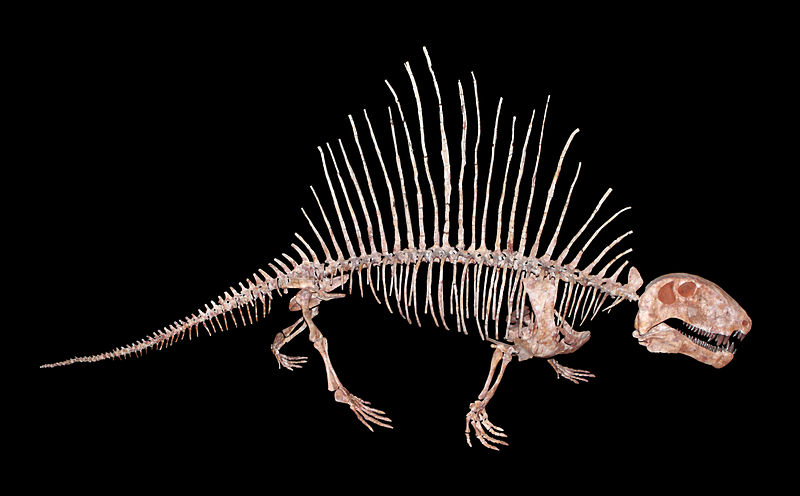 Apparently scientists seem to believe the Pelycosaurs practiced the
more advanced "costal
respiration", the chest muscle and diaphragm breathing common to modern
reptiles,
birds and mammals. Since no modern amphibians do this, we might
naturally assume that they were reptiles. But I
looked for more information, and it all seemed to suggest they were
amphibious.
Could they have been a "missing link", a stage between amphibians and
reptiles? Or even just plain amphibians?
Apparently scientists seem to believe the Pelycosaurs practiced the
more advanced "costal
respiration", the chest muscle and diaphragm breathing common to modern
reptiles,
birds and mammals. Since no modern amphibians do this, we might
naturally assume that they were reptiles. But I
looked for more information, and it all seemed to suggest they were
amphibious.
Could they have been a "missing link", a stage between amphibians and
reptiles? Or even just plain amphibians?
Today's amphibious anamniotes (creatures without an
amniotic sack - fish & amphibians that must lay eggs in water)
practice
"buccal breathing". As the whole bottom of the frog's or newt's mouth
or throat goes up, it closes its nostrils and air is pumped into the
simple
lungs. There are no muscles in the
chest pulling air into the lungs. Because of
this buccal breathing, frogs and toads generally have short necks and
large, flat heads, in order to have a larger lower mouth/throat/buccal
area compared to their body size. Newts and salamanders have smaller
heads but breathe the same way.
The Pelycosaurs' short newt-like neck as presented in some
images, and their slow metabolisms, seem to me to support the buccal
breathing idea.
Could the idea they used costal respiration be simply
an assumption, made early on and never challenged? The murkiness of the
subject was such that it
wasn't until the 1960s(?) that the whole order "amphibia" even had
their own name as distinct from reptiles.
(...-Fish-Amphibians-Reptiles-Birds-Mammals) Before that, the word
"amphibian" was mostly used as a functional term, and seals and otters
were described as "amphibians" because they live in and out of the
water. A creature that hatched as a tadpole in water and then grew into
a land dweller might easily be called a "reptile" - a salamander was
considered to be a species of lizard.
But in addition to throat breathing, amphibians make use
of their soft, moist
skin
for a considerable part of their respiration, especially to expel CO2.
Elimination of CO2 (according to the 'Modes of Ventilation' thesis) is
the harder part of air
breathing. Intake of oxygen is the easier part. And in the
Carboniferous probably through into the early Permian, there was still
some gradually decreasing CO2 remaining in the atmosphere, compounding
the problem. But the
larger the creature, the less skin area it has per volume of body, so
only very small animals respire just through the skin - mostly insects,
and a few small salamanders.
About the largest land-dwelling "typical" newt-like amphibian was the
Permian
Eryops, about 6 feet long.
Perhaps you too have just guessed it: I believe the
Pelycosaurs with their low metabolic rates were amphibious, and their
soft, moist skin would have been an
important part of their respiration. The sail greatly increased the
skin surface respiration area to enable a much larger
body size. At up to maybe 12 feet long and 150Kg weight for both
genuses, they were much the largest land
animals up to that time and would have dominated the environment by
virtue of that great size. The sail made this possible, especially in a
still less than ideal atmosphere.
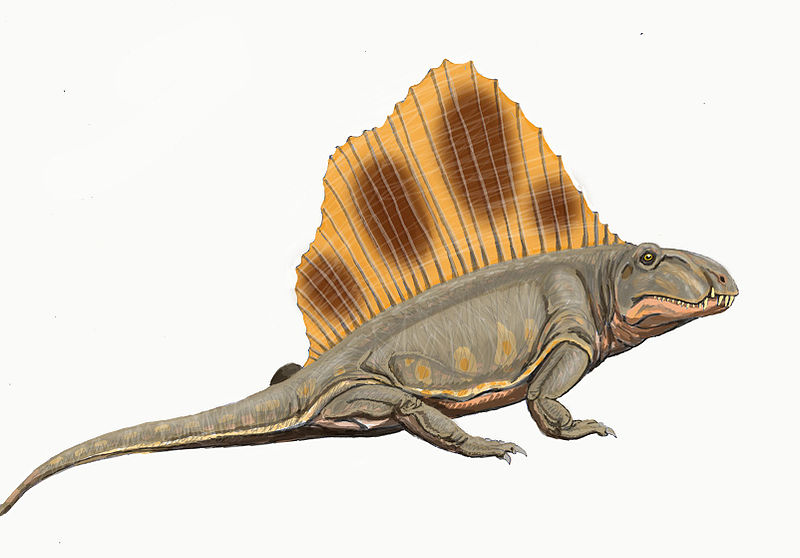 In this and other images, Dimetrodon seems
reminiscent of a giant salamander.
In this and other images, Dimetrodon seems
reminiscent of a giant salamander.
If it was a buccal (throat)
breathing creature like a salamander or
frog,
which also utilizes skin respiration as a vital part of its total
respiration,
the sail would have greatly increased its skin respiration surface
compared to its body volume, allowing the Pelycosaurs to grow
to be the largest land dwelling amphibians up to that time.
 An Edaphosaurus skeleton.
An Edaphosaurus skeleton.
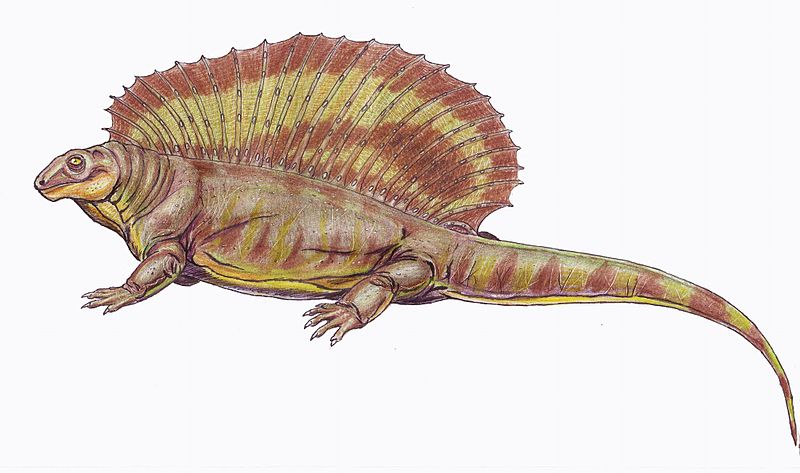 A short-necked Edaphosaurus image again
potentially suggestive of buccal (throat) breathing.
A short-necked Edaphosaurus image again
potentially suggestive of buccal (throat) breathing.
(I wonder what a swamp full of croaking Pelycosaurs would have sounded
like?)
Other info I found indicated that contrary to much art
depicting them in dry places (such as in the BBC series "Walking with
Monsters - Before the Dinosaurs"), it is said of both types that
they lived in swampy and wet areas -- typical for amphibians. Another
site indicated it had similar tastes in habitat to Eryops, a 6 foot
amphibian. (And
there were in fact at least a couple of smaller early amphibian
genuses, Ianthasaurus and Platyhystrix that also had
sails on their backs,
which line may perhaps have evolved into the Pelycosaurs.)
Then, one source said specifically that no Dimetrodon eggs
have ever been found. I found no mention of Edaphosaurus egg fossils
except that they were 'presumed to surely have been hard shelled',
which also implies that none have ever been found. Is that lack of eggs
just bad
luck, or could it be that Dimetrodon and Edaphosaurus laid soft shelled
eggs in the water and perhaps had a tadpole larval stage? Hard shelled
eggs, if they did exist, wouldn't preclude the 'amphibious' or
'prereptilian' breathing skin, but that none have been found does add
fuel to the idea.
(Afterthought: How would a reptilian male mount a female with a sail
for procreation? The sail would be much less of an impediment to
procreation in an amphibious species laying eggs in water, where the
male comes along and fertilizes the eggs after they're laid by the
female. Oh well, Stegosauruses must have done it somehow!)
A question that might have an answer or might someday get
one is: Have quite young Pelycosaurs been found, or only relatively
mature adults? Different size specimens found correspond poorly to
different ages, according to Wikipedia. Would a fossilized tadpole
Pelycosaur be recognized as such? Tadpoles attributed to Eryops have
been found.
Another web site mentions that Dimetrodon skeleton
microanatomy indicates it had a "low metabolic rate", with relatively
few channels for oxygen carrying blood. This too would be in keeping
with it being amphibious and a buccal breather.
This is mostly rather circumstantial evidence, but that
may be about the best we have for now about this far-off time. But a
picture emerges of a more orderly evolutionary timeline: Amphibians
emerged from the water sometime in the Carboniferous period as the
carbon
dioxide content of Earth's atmosphere became reduced enough to support
higher land animals. They evolved into the two probably amphibious
Pelycosaur species at least by the early Permian.
I noted the very heavy clavicles and sternum in the chest
behind the throat, seemingly fused or closely bound together. This
seemed like an ideal heavy attachment point for buccal breathing
muscles. I started checking other skeletons as further evidence for the
Pelycosaurs being buccal breathers. Yes, that was similar to known
amphibian Eryops's skeletal build.
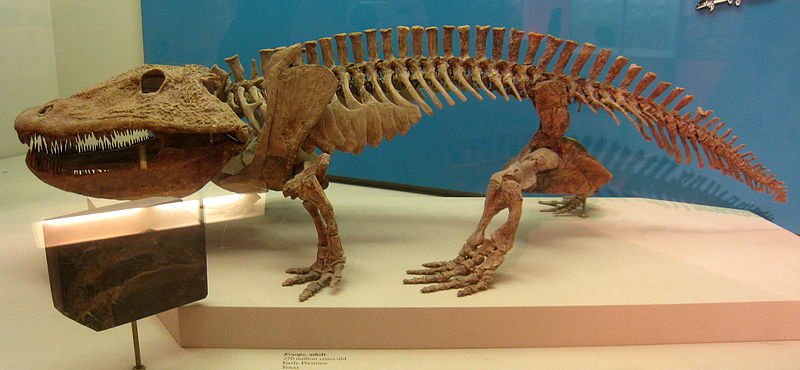 Eryops skeleton with similar heavy clavicles
and sternum
Eryops skeleton with similar heavy clavicles
and sternum
Then I started checking some known early reptiles:
Postosuchus,
Lystrasaur, Placerias... Sure enough, their chest bones were much
lighter. But I also noted that those I found were listed as being
"early
Triassic".
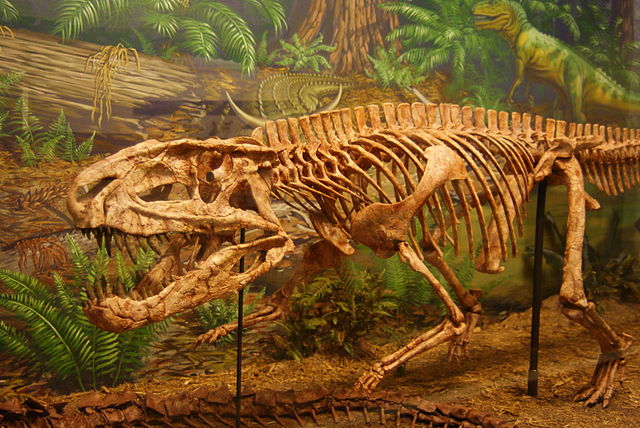 Postosuchus
Postosuchus
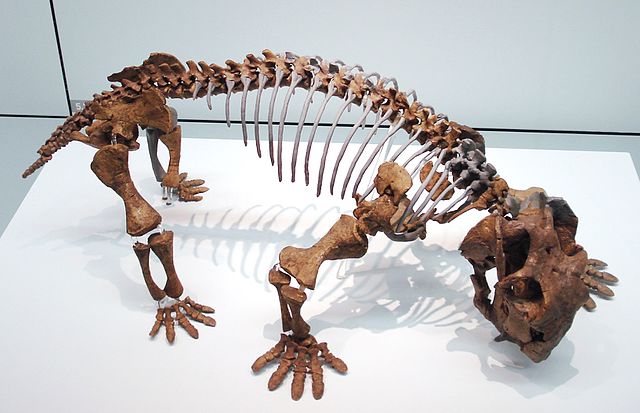 Lystrosaurus
Lystrosaurus
Both early reptiles were much lighter in the breast area than the
amphibians.
Then I came to Scutosaur, supposedly a reptile from the
late Permian. It had the heavy breast bones, similar to the Pelycosaurs
and amphibians.
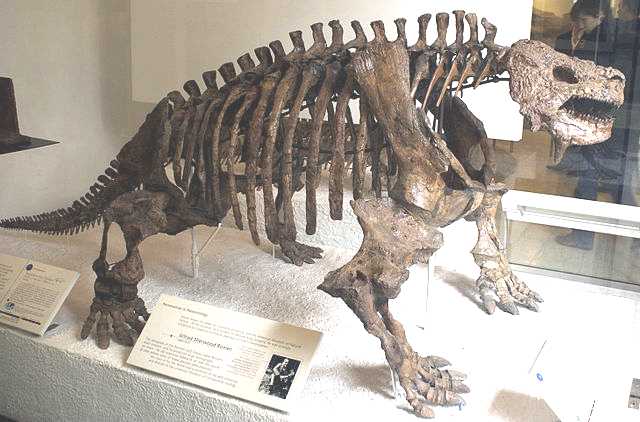 Scutosaurus Skeleton
Scutosaurus Skeleton
That appeared to shoot down
what had seemed like a fine piece of evidence - but only for a moment.
Scutosaur was listed as
being Pareiasaur genus, a member of the "Synapsids" once
known as "mammal-like reptiles". Some paleontologists have thought it
might be an ancestor of the turtle. But in the description was a most
revealing statement, in fact, a bombshell:
"Most authors have assumed a terrestrial lifestyle for
pareiasaurs, but bone microanatomy suggests a more aquatic, plausibly
amphibious lifestyle." [Wikipedia, 'Pareiasaurs']
If the Pareiasaurs (including for
example Bradysaurus, Scutosaurus and Bunostegos) were actually
prereptilian amphibians, the seemingly contradictory skeletal form
evidence was actually
virtually conclusive support! Bunostegos is explicitly denominated as a
"pre-reptile" in Wikipedia.
And from their
essential forms and proportions, to me it looks like they are probably
closely
related to - evolved from - frogs. (Frog skeleton images too seem to
show heavy breast bones relative to the whole skeleton.) We might
perhaps suspect two somewhat parallel strains of evolution, in size as
well as probably in increasingly sophisticated anatomy: from
'salamanders' to Pelycosaurs, and from 'frogs' to Pareiasaurs. The
Pareiasaurs appear to have evolved in Africa, where many fossils have
been found. But they seem to have spread over the world from there,
with all the continents being connected at the time.
 Bradysaurus.
Bradysaurus.
The form might suggest it evolved from a frog.
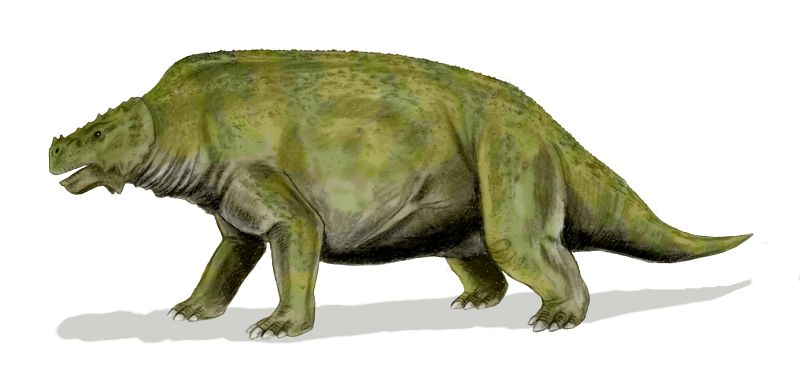 Scutosaurus
Scutosaurus
(The skeleton above looks far more froglike than this particular
rendition,
perhaps revealing how much may depend on the artist's preconceptions.
In fact, some of the form doesn't seem to follow the skeleton at
all.)
 Bunostegas, another Pareiasaur,
again looking like an overgrown frog or toad
(one "the
size of a cow"),
Bunostegas, another Pareiasaur,
again looking like an overgrown frog or toad
(one "the
size of a cow"),
and as with the others, having a "lumpy" skin with more
respiratory surface area than smooth skin would have.
(Apparently it was also the first creature with all four legs
essentially vertical, rather than sticking out to the sides. Evolution!)
Really, with all the similarities...
were these all just varieties of one species?
Most of the Pareiasaurs
were big, from .6m to 3m long, and considering the bulk and short tails
seem larger than Dimetrodon and Edaphosaurus, yet they had no sails.
How could they be so big, and evidently buccal breathing, yet
apparently with much less respiring skin area per volume? First, they
had wider
more frog-like proportions and so probably lung-breathed better than
the
newt-like Pelycosaurs with their narrower heads. Then, the atmospheric
CO2 level had dropped to insignificance, where it has since remained.
Then, as "prereptiles" they might have evolved more complex lungs.
Evidently the rest
came down to the skin texture. The Pareiasaurs had scutes, knobs,
folds, and lumpy skin textures. On a fractal level, all this could
bring about a much increased respiratory surface area over what
flat, smooth skin would provide.
On a further note, in both the Edaphosaurus and the
Scutosaurus skeletons shown above (but not necessarily in all
amphibians) we observe longer ribs extending back almost to the rear
legs. I suppose that with buccal breathing, the abdomen doesn't need
the flexibility it does for costal respiration.
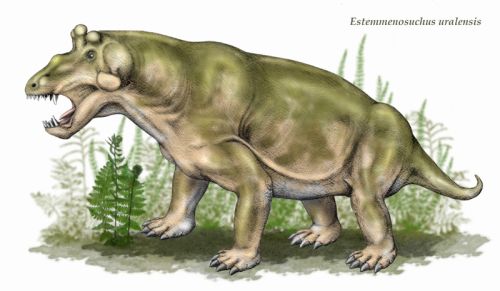 Looking more
deeply into creatures of the Permian on a site called http://palaeos.com/, I found the
mid-Permian Dinocephalia family. They also had very heavy
breastbones, and they seem to look a lot like the Pareiasaur "overgrown
frogs" above. Pictured is Estemmenosuchidae Uralensis. Again
they were said to be swamp dwellers, and were thought to be largely
vegetarian.
Looking more
deeply into creatures of the Permian on a site called http://palaeos.com/, I found the
mid-Permian Dinocephalia family. They also had very heavy
breastbones, and they seem to look a lot like the Pareiasaur "overgrown
frogs" above. Pictured is Estemmenosuchidae Uralensis. Again
they were said to be swamp dwellers, and were thought to be largely
vegetarian.
It started to look like all of the so-called "reptiles" of
the Permian period were in fact amphibians or at least prereptilian.
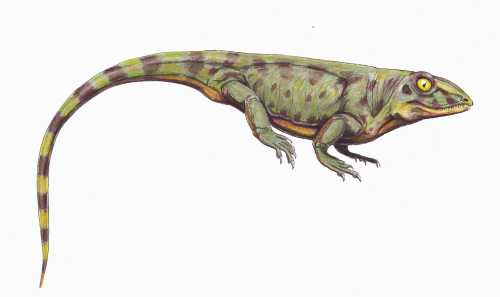 Another area I briefly
explored reinforced this view. Many of the early Diapsids, a
broad group presumed to be small early reptiles, again sounded like
they had
suspiciously amphibious lifestyles. I couldn't find any photos of
skeletons showing the chest area, just a couple of side view drawings.
In these they seemed to have the heavy breast bones, but it was hard to
be confident of it. Some were of salamander- or lizard-like formation.
Another area I briefly
explored reinforced this view. Many of the early Diapsids, a
broad group presumed to be small early reptiles, again sounded like
they had
suspiciously amphibious lifestyles. I couldn't find any photos of
skeletons showing the chest area, just a couple of side view drawings.
In these they seemed to have the heavy breast bones, but it was hard to
be confident of it. Some were of salamander- or lizard-like formation.
But might some of them actually be primitive frogs? In the
artists' images, many of the large rear feet and legs looked to me like
frog feet and legs. Would they not have been webbed? This considerable
size difference commonly found between rear and front legs was also
noted in writings. (Oops... I've lost the link to the item where I
first read
this and about the 'aquatic' or 'amphibious' habits of many types. And
where is the bone microanatomy analysis?) It
was thought that the long rear legs would be for 'bipedal' locomotion,
but they could
instead be for jumping, or lunging forward at prey. Some seemed to have
shorter tails, but it
didn't seem that any had no tails. Juvenile frogs have tails, and
perhaps adult primitive frogs might still have had tails. Even the
pareiasaurs had short tails. The rear end anatomy doesn't look like
modern frogs, but perhaps primitive frog ancestors might have used
their front limbs to assist in launching, and their tails for balance
in the air. But whether salamanders or frogs, it looks to me like yet
another case of amphibians having been misidentified as reptiles, again
no doubt
starting in past times when there was no distinct scientific
classification called "amphibia".
Here's a related note: Two broad
divisions of Diapsids have been
identified: the Lepidosauromorpha and the Archosaurs.
In one text the Lepidos are described as having a heavy sternum (and in
Wikipedia as having a 'primitive sprawling gait' - legs to the sides).
Since the heavy sternum seems to be a distinguishing amphibian
characteristic, perhaps the two classifications have unwittingly
divided the amphibians from the reptiles. (But I have not checked this
out.) If that's the case, the Lepidos probably evolved into the Archos.
Then I did a search specifically on "frog fossils". Based
on lack of earlier fossil finds, frogs were long thought to have first
evolved in the Triassic period. Recently frog remains from the early
Permian have been found, which puts a different slant on things. (Now
where was that link?) Also the wide divergences in finds from later
times is said to indicate that frogs and salamanders likely radiated
away from each other in the Carboniferous. Amphibamus is a late
Carboniferous creature said to be "froglike", yet with a tail. Even so,
in the absence of any reptiles, earlier Permian frogs certainly might
well have become later Permian Dinocephalians and Pareiasaurians, which
after all have short tails themselves.
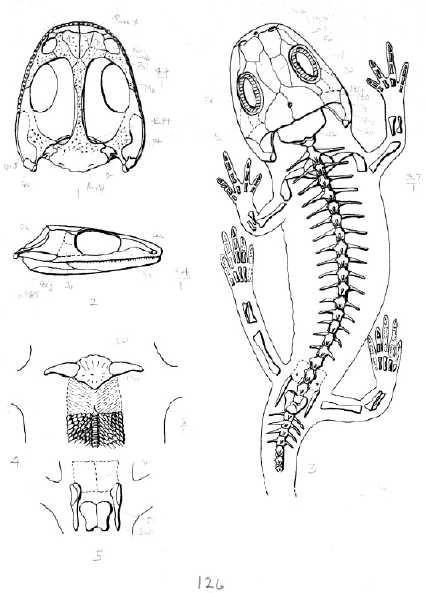 Amphibamus grandiceps Cope, textbook
drawing of the type specimen [georgesbasement.com]
Amphibamus grandiceps Cope, textbook
drawing of the type specimen [georgesbasement.com]
...20cm long Amphibamus, "a poorly understood prehistoric amphibian."
But much seems to be speculation and confusion about the Permian period
and amphibian evolution.
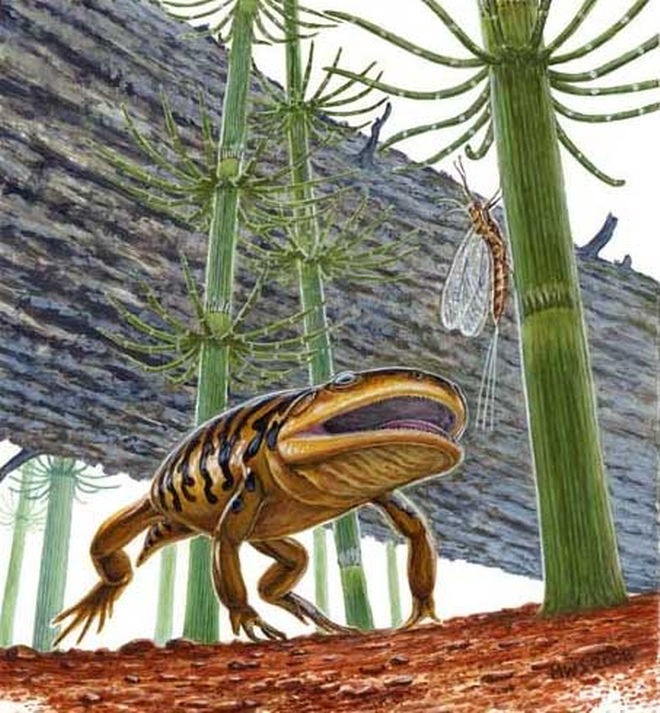 "Frogamander" from the early Permian
"Frogamander" from the early Permian
"In its Early Permian habitat in Texas, Gerobatrachus hottoni would
have lived on land and water where it could lunge after insects like
this mayfly Protoreisma. - See more at:
http://www.livescience.com/2554-frog-amander-fossil-fills-evolutionary-gap.html#sthash.YjIPrNN2.dpuf"
But groups of creatures from the late Permian such as the
Gorgonopsia and the Dicynodonts, didn't and don't seem to fit into the
otherwise neat scenario of the 'amphibious
Permian'. In the mid Permian the newly appearing seed bearing plants
began to provide a good food supply for land dwelling vegetarians, as
detailed on Paleos.com:
"While animals were undergoing a change so
were plants, with xerophyletic (dry-adapted) species of ferns,
seed-ferns, conifers and ginkgos coming into prominence. The
Glossopteris flora dominates in Gondwanaland. These new plants mark the
transition between the Paleophytic (the old spore-bearing moisture
loving coal swamp plants) and the Mesophytic (gymnospermous) era of
plant evolution. Significantly, whereas animal life has its big
transition at the very end of the Permian, plant life switches over to
a more modern flora some ten to twenty million years previous."
and
"But
now in the Kungurian [mid Permian] we see an environment dominated by
medium to large sized herbivores (the pelycosaur family Caseidae). This
very important event marked the shift from a food chain based on
detritus and carnivory (insectivore/ piscivore/ carnivore) to a more
efficient one in which plants as primary producers provide the main
input. The Lopingian Epoch (Late Permian) witnessed a succession of
impressive medium to large herbivores - caseids, estemmenosuchids,
deuterosaurs, tapinocephalids, and dicynodonts - with (apart from the
dicynodonts) each "dynasty" flourishing briefly then dying out after
only a few million years, to be replaced by a new wave."
So it would appear that land animal evolution hit an
accelerated pace once there were food plants, and this probably
fostered the transition from amphibians to reptiles. Then large,
sluggish amphibians who previously had the world to themselves would
have been easy prey for agile reptiles, so the transition once begun
could have been completed in a relatively short time.
The saber-toothed Gorgonopsids date to the late Permian.
Their form, skeleton (with light clavicles and sternum) and bone
microanatomy indicate they were terrestrial creatures having costal
respiration: reptiles. Certain bones had moved from amphibious
positions to form
the inner ear so they would hear best in air, again saying they were
reptiles,
not amphibians. Notwithstanding some "mammal-like" qualities and
outline, I
suggest from their late Permian timeline just before the Triassic
explosion of reptilian types, that they must have been the earliest of
reptiles. Scutosauruses were doubtless their easy prey, and when they
died out, so did the Gorgonopsids.
So it is possible that the late Permian (the "Lopingian
Epoch", or perhaps the last 15-20% of the period as currently
described), might better be described as belonging to the early
Triassic, if one would describe the Permian as a period dominated by
amphibian evolution, and the Triassic by early reptiles. At any rate it
seems to have been an age of rapid transition between the two.
In conclusion, herein I believe I've uncovered and
corrected what appear to me to be some large misconceptions about the
order of evolution and the nature of many Permian creatures. This
certainly doesn't clear away all the murk from this distant time, but I
think it's a good start!
Electric
Hubcap
Motor
Systems
-
Electric
Transport
Electric
Hubcap motor, Chevy Sprint & Variable Transmission

Planetary Gear Torque Converter
("PGTC") Works
Great, Starts Car Moving Great!
I'll start with an important conclusion: I was wrong in
2012 that the planetary gear torque conversion doesn't start working
until the vehicle is in motion. With a smooth, balanced
slipping/tensioning mechanism, it works just fine from a stop. In 2012
it was just too crude to work properly under many circumstances,
leading me to draw false conclusions. And in fact, a misconception
continued into May 2016.
For much of May I was puzzled that things worked great if
the required torque was under around 20 foot-pounds ("F-P"), but it
balked at much more than that. When the tension was directed more
evenly around the pulley so it didn't pull to one side, even with a
cable tie as a quick experiment,
this figure rose a little. But it wasn't the answer.
I started figuring that the output torque could only be
increased to a certain point for a given RPM of the slipping gear and
ratio between them. Probably there's a "maximum torque ratio" between
the gears as well as a gear ratio. If instead of the slow moving
planets assembly I use the fast moving sun gear as the slipping gear,
the torque should be multiplied much more, and the unit can have
perhaps ten or twenty times the maximum torque - plenty to put the car
on the road.
But now I've seen how smoothly the system runs when
working within its limits.
I'm finally convinced that this, the Planetary Gear Torque Converter
("PGTC"), must be about the 'ultimate' form of automotive transmission
one could come up
with. It needs to be set up right... and then produced for car
transmissions and add-on wheel drives.
A Better Planetary Gear?
I started thinking a large diameter UHMW planetary gear
several
inches wide with plastic planet gears that don't need lubrication would
be an ideal form of the gear for a car. UHMW would also have
the least possible friction with very low heat and losses. Aluminum
might be the best metal for the sun and ring gears. It's all about
spreading out the stresses so the lighter materials can handle them
even for a large, heavy vehicle.
Perhaps thus constituted they could also be straight gears
instead of helical for highest efficiency, without being noisy like
metal straight ('spur') gears are. Conceivably too, they could be
composed of
two or more planetary gears placed in parallel and bolted together,
with the teeth offset between units so that they were at different
points of engagement at any given time, spreading out any unevenness
caused by straight gears. Or with full width sun and ring gears, the
planets assembly might contain narrower planet gears, placed at offset
rotations. Such strategies might attain the general smoother,
quieter drive effect of helical gears, without having the helical gear
sideways thrusts and losses.
With such a planetary gear and a toothed or flat drive
belt instead of a chain, no lubrication would be required except for
greasing the bearings, which, with modern sealed bearings, is very
rarely needed.
One fly in the ointment is that cutting precision gear
teeth even in softer materials looks like a serious challenge, unless
they can be waterjet cut from thin pieces and built up into thick ones.
But, even if one chose larger, coarser teeth than might otherwise be
desired, would that be precise enough? I doubt my ability to do a
satisfactory job of it, even spending considerable time setting things
up.
On the 31st I looked on the web.
I found a planetary gear (Swiss company Gysin.com GPL120) that
looked like it would be notably better than typical automotive
planetaries, but it's a sealed (lubricated) unit with bearings, and
units with plastic planet gears. Presuming the price isn't out of
reach, why try to fabricate something difficult that someone else
already specializes in that's doubtless the best? It makes the prospect
of manufacturing transmissions a lot simpler! I sent off an e-mail to a
US distributor.
Another company makes gears to order, including from
plastic. So an option might be to take an automotive planetary gear and
make a housing that would give the benefits of the gysin housing, with
plastic gears replacing the steel ones to remove the lube requirements.
If they would handle the torque.
A couple of days later an inquiry found that there is a
company making still larger planetary gears 'for 4x4 offroading', right
here on Vancouver Island. But the prices were scary. Unfortunately it's
not near Victoria, but I may take a trip up there some time to have a
look.
Motor Phases Were Miswired between
Cables
I noticed that the motor occasionally wouldn't start
spinning until it was run the other way or manually turned to a new
position. That seemed inexplicable. And I and thought of how it wasn't revving up very well in
reverse. On the 8th I disconnected the pulley rope so it was
free-spinning except for the flywheel. It still worked poorly in
reverse. Somehow, I must still - or again - have the drive phases
wrong! I hooked up a DC current clamp meter and started swapping drive
wires at the plug. Sure enough, they were wrong. When I had them right,
the motor started and spun freely in both directions and the motor
currents went
way down into the lower 10s of amps once up to speed. Instead of seeing
150 or more amps under load, it was down around 100 even while driving
forward. It explained why the motor had seemed to take substantially
more energy than with my controller, and of course it generated
considerably more heat - another problem explained!
How had this happened - again? I had the wire colors
clearly marked, but somehow they were wrong again. AHA!... Some hall
sensor wires had to be crossed between the handheld control box and the
driver's seat controls, so when I switched, the phases got switched at
the sensing side. That makes sense. If they were wrong in the handheld
control, it would also explain how it was that they were wrong earlier
when I changed from my controller to the Kelly. I've probably put them
back the way they were originally. (I may have cross-wired the Kelly
handheld control myself since it had the wrong plug for my motor, but I
knew I didn't like
Kelly's arrangement of having the motor sensor cable and the controls
cable both connected in the same "J2" plug in the controller! Thus
changing the operator controls means changing the motor sensor cable as
well. They have two different functions and should have separate
cables.) I'll say this for it: nothing blew up in spite of the fault,
even if the motor got smoking hot a couple of times.
So that cleared up some small mysteries and solved a
couple of problems, but it didn't make the car move any better,
including backward. Experimentally oiling the rope and pulley just made
them spin freely in spite of all tensioning.
Adjustments: Changing the chain
sprocket to a lower final drive ratio (3:1), and to a stronger tension
rope spring.
The spring was rubbing on the pulley and making a metal on
metal noise. Changing the spring to a smaller diameter should stop
that, and at the same time, any change there would be an adjustment,
with the possibility the car would roll better. or worse. or at least
that I'd learn something. Fortuitously I had recently found a spring
that seemed just right. But it proved to be weaker and I put the old
one back in.
Then, notwithstanding that it didn't have much torque, I
thought I would try changing the 4 to 1 final chain drive ratio to 3:1,
from a 12 tooth sprocket to 16, driving the 48 tooth one on the
differential. That would allow street speeds (not highway) without
over-revving the motor. In theory all that should mean was the
variable torque converter ratio
should change to compensate. I had a sprocket gear welded up, and
changed it on the 14th. Instead of an hour, it took all afternoon to do
everything and readjust it all.
The first results were perhaps predictable. Instead of 10
foot-pounds ("F-P" herein) or so to start moving at an easy to start
point, it required 1/3 more. Before, I could get the car to roll where
it needed 20, but this time it seemed to take more tension, and I
pulled the lever back until the spring clamp on the cable hit the cable
sheath, without getting enough to get the car moving at any time. The
motor would still start turning at this maximum tension, without moving
the car. It definitely needed a stronger spring.
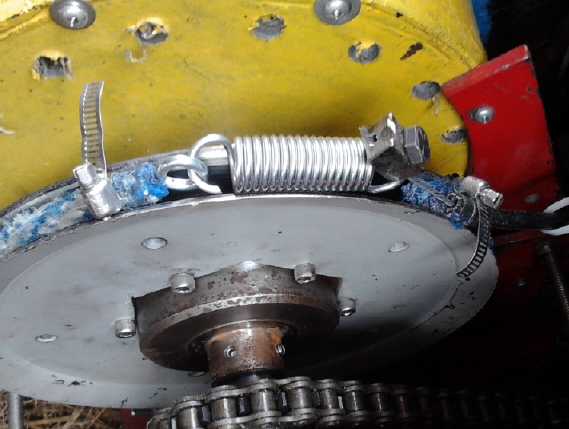 On the 18th I
put a new spring in. The wire in this one
was 1.1" diameter instead of .85". It was even fatter than the old one
(3/4" O.D.) and so scraped even worse on the pulley. (For now, oh
well!) Much to my surprise, on pulling the stick back a little harder,
from an easy to roll position the car readily started and drove ahead.
As per the theory, the extra torque was provided by a higher ratio from
the planetary gear torque converter. In fact it seemed better than
before. (How far can this be taken - to 2:1, or even 1:1? If so highway
speeds should be attainable.) It even backed up a bit, if still not
very well. (It would have backed out of a level, paved parking spot -
yay!) But from a tough spot it still wouldn't go ahead and the spring
hit the end stop. So I torched another inch and more off the tensioning
rope and reattached everything. It helped, but it still wouldn't move
from that spot, which turned out to need almost 50 F-P (150 F-P at the
wheels). Again I was pulling the lever all the way back, and I got the
feeling an even stronger spring would definitely help.
On the 18th I
put a new spring in. The wire in this one
was 1.1" diameter instead of .85". It was even fatter than the old one
(3/4" O.D.) and so scraped even worse on the pulley. (For now, oh
well!) Much to my surprise, on pulling the stick back a little harder,
from an easy to roll position the car readily started and drove ahead.
As per the theory, the extra torque was provided by a higher ratio from
the planetary gear torque converter. In fact it seemed better than
before. (How far can this be taken - to 2:1, or even 1:1? If so highway
speeds should be attainable.) It even backed up a bit, if still not
very well. (It would have backed out of a level, paved parking spot -
yay!) But from a tough spot it still wouldn't go ahead and the spring
hit the end stop. So I torched another inch and more off the tensioning
rope and reattached everything. It helped, but it still wouldn't move
from that spot, which turned out to need almost 50 F-P (150 F-P at the
wheels). Again I was pulling the lever all the way back, and I got the
feeling an even stronger spring would definitely help.
I pulled the car a few
inches up the 'hill' to where it
"only" needed - if I recall correctly - about 35 F-P. (was it really
that much? - over 100 F-P at the wheels? I should have tried it again
to confirm that - I was probably mistaken.) and it did start, and drove
ahead until I stopped it.
It seemed it was approaching the point, at least the order of
magnitude, required to put it on the street. It seemed the stronger the
tensioning spring, the more torque the drive had available. Could it
really be that simple?
That was the strongest spring in the drawers at Capital
Iron. Somewhere I had to find a still stronger one, and I had to make
some sort of proper mounting so it didn't rub on the pulley. And
perhaps one
that would provide some leverage so one didn't have to pull the stick
so hard. It occurs to me that a 12" pulley would require lower tension
forces for friction than the 10" one. But I couldn't easily have fit
the larger size. It would have been in the way of the speedometer gear,
if nothing else.
Mounting Bracket for Tensioner Cable, Lever & Spring
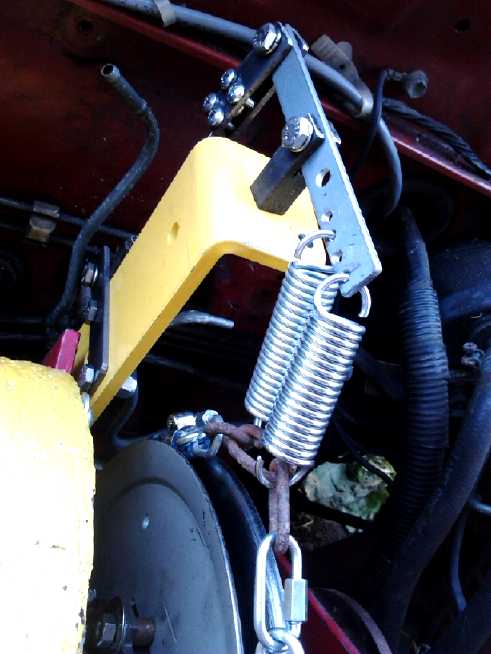 Obviously I
was going to have to make another attachment
to the transmission - hopefully without complete disassembly again. On
the 19th I started looking - by no means for the first time - to see
how I might mount the cable for an even, smooth pull in both
directions. This time I came up with the idea of linking the two ends
of the tensioner rope with a short chain, and having the spring pull
the chain outward at right angles (upward). If there was just a bracket
sticking up above the pulley, it could anchor the cable sheath. The
cable could pull down on a lever, and the other end of the lever would
pull up on the spring. Two springs might easily be fitted to double the
strength of the tension, and the lever could hinge at a point nearer
one end to give the driver more leverage, too.
Obviously I
was going to have to make another attachment
to the transmission - hopefully without complete disassembly again. On
the 19th I started looking - by no means for the first time - to see
how I might mount the cable for an even, smooth pull in both
directions. This time I came up with the idea of linking the two ends
of the tensioner rope with a short chain, and having the spring pull
the chain outward at right angles (upward). If there was just a bracket
sticking up above the pulley, it could anchor the cable sheath. The
cable could pull down on a lever, and the other end of the lever would
pull up on the spring. Two springs might easily be fitted to double the
strength of the tension, and the lever could hinge at a point nearer
one end to give the driver more leverage, too.
I finally found what looked like a good piece of steel for
the bracket among my scraps, pre-painted yellow. I took the motor off,
estimated where things should be, drilled holes, and fitted it on. I
had to drill one hole in the body wall of the transmission. As I didn't
want to disassemble everything, I did it in situ with a cordless drill.
It took quite a while and tapping threads was also slow. It must
be harder than the usual "mild steel".
By the time I had it attached, I'd had enough and had
other things to do, and packed it up for the day without fitting
anything to it. At least at this point I had a pretty specific plan. On
the 20th I made a pivot piece and a lever to attach the cable to, and I
put an eye hook screw on the other end of the rope. Some chain links
connected the two eye-hooked rope ends together. More time had been
taken shopping for the bits (and then for unrelated things) than
making, and that was as far as I got.
On the 21st I got it all connected and replaced the motor.
It worked much the same as before, again with the car balking when
higher torques were required, the motor spinning without moving the
car. Again that seemed to be because I couldn't pull the spring as
tight as I wanted. This time it was limited swing of the lever, which
hit its end stop before the spring was tight enough to load the motor
down heavily enough. On the bright side, it was quieter without the
metal spring rubbing on the pulley, and it would now be easier to
change things. The cable sheath was firmly clamped on. The end stop
could be ground down a bit, the spring's position on the lever could be
moved up or down with another hole, and the spring could easily be
changed - or perhaps two of them could be employed.
The next day I ground down the end stop so the spring
could be pulled farther. That didn't seem to change much, so I went out
and got another spring. This time I didn't pull back very far on the
stick before the car started moving. But it still didn't like starting
to move if the required force was over about 25 F-P. I could tighten
the tension more now, but still if it was more than that, the motor
simply slowed down. It seemed it would do 30 F-P for a moment while the
motor and flywheel slowed, but not for very far if it had to be kept up.
The theory of course was that it would do twice the torque
at half the speed, but that still only seemed to apply up to 20 or 25
F-P.
That's the most yet, but it needs 50 or better (150 at the wheels) for
the road. Far from being "ultra-efficient", it was simply losing higher
torque than that to friction somewhere. The rope and pulley got very
warm. As the motor got hot.
Between the planetary gear and the chain reduction, the
motor had about a 5 to 1 reduction to the wheels. Really, it might run
as well or nearly as well just with any (working) clutch, without the
addition of the variable torque converter component. Where was the
theory not carrying over into practice?
Camera: View the workings?
I couldn't see into the hood from the driver's seat. I
decided I needed to mount a video camera right by the transmission. I
could run the car, then review the close-up video and see if there was
anything that might show what problem or problems there were with the
system. On the 23rd instead I got someone to hold the camera. In
reviewing the videos, it seemed the cameraman hadn't really got in
there where I wanted to see. I guess he didn't want to get run over.
However, the next day I did a little more driving. The
thrust bearing was loose again, and then I noticed that the set screws
on the ring gear were at a different rotation on the shaft than where
I'd set them. And this was the second time they seemed loose.
Apparently the ring gear could turn without the output shaft following
it! Since it was a splined tenon inserted over a 5-pointed "star"
shaft, this should have been impossible. Apparently not! The points
must have worn down. Well, it was always a 'cludjed' arrangement,
evidently another of my "not robust enough" pieces. One of the set
screws was now at the keyslot on the shaft, so I screwed it down into
the slot, which should keep it from sliding regardless of torque.
I thought that would have explained and solved everything,
but I still couldn't get the car to start moving if it took over 25
(75) F-P or so.
But I found I could stand with a foot outside the driver's
door and still reach the pedal with my other foot, once I had set the
tension lever to a desired point, and look at the shaft as I started
the motor turning. The ring gear may have twisted around the shaft
before, but it wasn't doing so now. Now what?
It's all in the adjustments? - Nope.
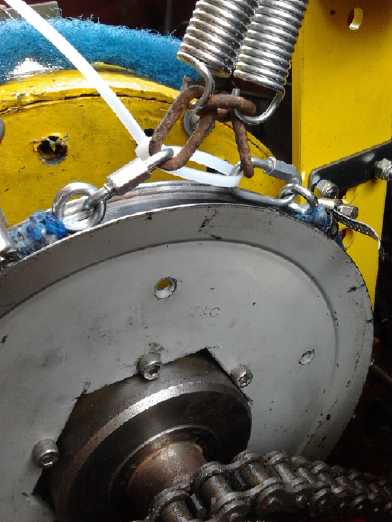 I returned on
the 25th and did much the same. If the
pressure wasn't too much, one could see the slipping gear & big
pulley turn one way as the shaft turned the other, moving the car
forward. With the stick pulled tighter, the pulley turned less and the
motor turned slower, but again the car pulled ahead. It all seemed
smooth, predictable and according to theory.
I returned on
the 25th and did much the same. If the
pressure wasn't too much, one could see the slipping gear & big
pulley turn one way as the shaft turned the other, moving the car
forward. With the stick pulled tighter, the pulley turned less and the
motor turned slower, but again the car pulled ahead. It all seemed
smooth, predictable and according to theory.
I thought, well, the bottom anchor end of the tensioning
rope was very close to the pulley, while the other end being pulled had
somewhat more slack. That would mean the pulley was being pulled a
little off-center, and the higher the tension, the more off-center the
pull would be. Could that small factor make the difference when the
torque got too high? I put a cable tie between chain links and pulled
things tighter together. There would be more tension with the rope
lifted away from the pulley less.
The car pulled ahead, if grudgingly, from a
zone probably requiring 30 (90) continuous F-P. It seemed
the off-center pull was indeed the source - or at least an important
source - of friction that increased rapidly as the motive forces got
higher.
Before the mounting, the ends of the rope were simply
being pulled towards each other at the radius of the pulley. After the
ends were being pulled away from the pulley. At the far (bottom) side
of the pulley, the rope was held about 3/4 of an inch away from the
pulley. With the first system, the pulley was being pulled toward the
bottom when the rope was tightened. With the second, it was being
pulled toward the top, and the higher the torque, the more off center
it was.
I determined to replace the rope, which was now a little
short anyway with the cuts made, and make a noose that could be moved
in or out a bit with pipe clamps to adjust the height to match the
bottom.
At this point it appeared that the theory worked great,
and once again it was my somewhat flimsy construction with sloppy
tolerances that has been the problem. For a prototype, it'd have to be
excused.
But I got the pulley forces, I thought, more or less
centered without much improvement on the 31st. And, playing with a
spare planetary gear albeit not an identical one, it started to not
make sense - I could put sideways forces on it, and it still meshed
pretty smoothly. It still worked best under the magic 20 F-P.
In the meantime, on the same day I was considering buying
a planetary gear for a production prototype. As I did so, a better idea
of what the problem was came to me. Interactions with the slipping gear
turning a certain speed made for a certain maximum level of torque on
the output. That apparently was 20 foot-pounds. If that speed was
higher, the maximum torque would be higher. The speed could easily be
obtained by using the sun gear as the slipping gear instead of the
planets assembly. It seems to me the
Toyota Prius arrangement is that way. But that means changing pretty
much everything. I couldn't see using the same or another surplus auto
gear for a one-off
and then having to redesign it for production. I decided that for this
experiment I should buy a nice enclosed planetary gear and have the
chassis parts cut by CNC abrasive waterjet. If it worked, it would also
be the production prototype.
Then I started think about it more. If the shaft for the
motor stuck out one end and the shaft for the slipping gear the other,
with the chain sprocket to the differential being on the ring gear in
the middle, the whole unit could be enclosed in the original
transmission case, even if that might need to be hacked up somewhat. In
that case (bad pun!), it could contain a little gear oil for
permanent lubrication, and issues of using plastic gears would vanish.
It wouldn't be quite as efficient as what I've been visualizing, and it
would depend on getting the transmission from the same model of car,
but it would be good enough. All the regular gears and shafts inside
would be replaced by the one planetary gear. Solving the lubrication
problems and keeping dust and grime out are important.
On June 3rd I went out to the shed to get the transmission
housing, but a bunch of wasps came out of the cardboard box it was
under. Ugh, a hive! I decided to wait until dark and then pull the box
out with a long rope. Then I could take the garden hose to it.
"Permanent
Magnet Assisted" Unipolar Motor
Just a note
When I think that neo
magnets will fit into the existing toroidal core motor coils in the
"ARM" motor, it now seems fortuitous that I built it, and didn't get
around to doing the "Transverse Flux" reluctance motor idea. I might
now come up with some good way to put neo magnets into a transverse
flux motor, but it will require some design changes with some different
waterjet cutting patterns. The old motor would have turned out to be a
dead end, where the existing ARM motor can be "upgraded". I hope to
have the Sprint working in June (or maybe July) and so at last turn my
attention from
the variable torque converter to other things such as this.
Turquoise
Battery
Project
-
New
Chemistry
Battery
Making
Source of Electrolyte
I went to look for potassium chlorate as a strong oxidizer
to oxidize the surface of the carbon fiber, but I absently typed
"potassium sulfate" by mistake. I found it as a fertilizer for
agriculture, 0-0-50. That seemed too easy! I called a local supply to
ask if they had it. By the time the lady returned to the phone I
realized my mistake. Oops, how had I come up with the wrong chemical?
They did have it, and I thought I might get some for the
garden. Only after I hung up did I remember that potassium sulfate is
my battery electrolyte! That explains why I had absently typed the
wrong search term.
...A 25Kg bag for 54$. That sure has to beat mixing small
quantities of sulfuric acid and potassium hydroxide! Once again, if you
know where to look, you can probably find something. But it certainly
was an odd search sequence that took me straight to a cheap source!
I went there and ended up just getting a 2Kg box. It
didn't actually specify the chemical on the box, and I'm not sure of
the purity. It seemed better to get a little to try out.
Oxidizing Graphite for the
Positrode
When I typed the right chemical to search for, potassium
chlorate, in the search results was a way to make it using bleach and
potassium salt (NaClO + KCl), both of which I have. But it looked
complicated, and I decided instead simply to put some bleach in a pail
and toss in some carbon fiber cloth. That sat there the rest of the
month as I didn't have time to look at it.
The cell I made in April also sat for the month with a
small charge on it - the other method of oxidizing the positrode. It
didn't seem to have much current capacity. I added water a few times.
It didn't seem to improve with the charging. Finally on June 3rd it
occurred to me that there was no particular reason the carbon fiber
should be "battery purity" since that's not what it's made for. If it
had any nitrates or nitrites present in it, it would self discharge via
the "nitrate-nitrite shuffle". Or the Glycerin might produce something
as it oxidized. That these things didn't occur to me much sooner can
only be ascribed to having too many projects on the go at once, and
giving most of my attention to the PGCT.
The thing to do would be to flush out the electrolyte. The
beeswax seemed to have come off the far end. That simplified what I
thought would be tricky, as water could be run right through the cell.
Black powder (nickel or nickel oxide) came out, along with brown
liquid. I put it back on charge. Leter the discharge rate seemed to
have dropped in half, but it was still much too high. I suppose it
takes more than a quick rinse to clear out the water absorbed into the
separator sheet.
Nickel Ion Battery?
It seems that if one uses potassium sulfate in the
electrolyte, the nickel will stay
solid in all its oxidization forms. But according to the article below
(sent to me once again by Leonardo), if one uses instead nickel
sulfate, Ni++ ions coming off the negative will be dissolved and
migrate to the plus side. If something is made on the plus side to hold
all those ions, a battery cell is formed.
Secondary batteries
with multivalent ions for energy storage
Chengjun Xu1, Yanyi Chen1, Shan Shi1,2,
Jia Li1, Feiyu Kang1,2 & Dangsheng Su3,4
www.nature.com/scientificreports
See discussions, stats, and author
profiles for this publication at:
https://www.researchgate.net/publication/281779613
Secondary batteries with multivalent
ions for energy storage Article in Scientific Reports
· September 2015
Abstract:
The use of
electricity generated from clean and renewable sources, such as water,
wind, or sunlight,
requires efficiently distributed electrical energy storage by
high-power and high-energy secondary
batteries using abundant, low-cost materials in sustainable processes.
American Science Policy
Reports state that the next-generation “beyond-lithium” battery
chemistry is one feasible solution
for such goals. Here we discover new “multivalent ion” battery
chemistry beyond lithium battery
chemistry. Through theoretic calculation and experiment confirmation,
stable thermodynamics and
fast kinetics are presented during the storage of multivalent ions
(Ni2+, Zn2+, Mg2+, Ca2+, Ba2+, or
La3+ ions) in alpha type manganese dioxide. Apart from zinc ion
battery, we further use multivalent
Ni2+ ion to invent another rechargeable battery, named as nickel ion
battery for the first time. The
nickel ion battery generally uses an alpha type manganese dioxide
cathode, an electrolyte containing
Ni2+ ions, and Ni anode. The nickel ion battery delivers a high energy
density (340 Wh kg−1, close to
lithium ion batteries), fast charge ability (1 minute), and long cycle
life (over 2200 times).
Received: 18 November 2014
Accepted: 21 July 2015
Published: 14 September 2015
I'm not sure I want to tackle such an idea (having little
enough success with seemingly simple chemistries), yet it is an
interesting one. Again nickel is identified as the substance with the
most benefits of the metals considered.
http://www.TurquoiseEnergy.com
Victoria BC Canada


 Apparently scientists seem to believe the Pelycosaurs practiced the
more advanced "costal
respiration", the chest muscle and diaphragm breathing common to modern
reptiles,
birds and mammals. Since no modern amphibians do this, we might
naturally assume that they were reptiles. But I
looked for more information, and it all seemed to suggest they were
amphibious.
Could they have been a "missing link", a stage between amphibians and
reptiles? Or even just plain amphibians?
Apparently scientists seem to believe the Pelycosaurs practiced the
more advanced "costal
respiration", the chest muscle and diaphragm breathing common to modern
reptiles,
birds and mammals. Since no modern amphibians do this, we might
naturally assume that they were reptiles. But I
looked for more information, and it all seemed to suggest they were
amphibious.
Could they have been a "missing link", a stage between amphibians and
reptiles? Or even just plain amphibians?





 Looking more
deeply into creatures of the Permian on a site called http://palaeos.com/, I found the
mid-Permian Dinocephalia family. They also had very heavy
breastbones, and they seem to look a lot like the Pareiasaur "overgrown
frogs" above. Pictured is Estemmenosuchidae Uralensis. Again
they were said to be swamp dwellers, and were thought to be largely
vegetarian.
Looking more
deeply into creatures of the Permian on a site called http://palaeos.com/, I found the
mid-Permian Dinocephalia family. They also had very heavy
breastbones, and they seem to look a lot like the Pareiasaur "overgrown
frogs" above. Pictured is Estemmenosuchidae Uralensis. Again
they were said to be swamp dwellers, and were thought to be largely
vegetarian. Another area I briefly
explored reinforced this view. Many of the early Diapsids, a
broad group presumed to be small early reptiles, again sounded like
they had
suspiciously amphibious lifestyles. I couldn't find any photos of
skeletons showing the chest area, just a couple of side view drawings.
In these they seemed to have the heavy breast bones, but it was hard to
be confident of it. Some were of salamander- or lizard-like formation.
Another area I briefly
explored reinforced this view. Many of the early Diapsids, a
broad group presumed to be small early reptiles, again sounded like
they had
suspiciously amphibious lifestyles. I couldn't find any photos of
skeletons showing the chest area, just a couple of side view drawings.
In these they seemed to have the heavy breast bones, but it was hard to
be confident of it. Some were of salamander- or lizard-like formation.

 On the 18th I
put a new spring in. The wire in this one
was 1.1" diameter instead of .85". It was even fatter than the old one
(3/4" O.D.) and so scraped even worse on the pulley. (For now, oh
well!) Much to my surprise, on pulling the stick back a little harder,
from an easy to roll position the car readily started and drove ahead.
As per the theory, the extra torque was provided by a higher ratio from
the planetary gear torque converter. In fact it seemed better than
before. (How far can this be taken - to 2:1, or even 1:1? If so highway
speeds should be attainable.) It even backed up a bit, if still not
very well. (It would have backed out of a level, paved parking spot -
yay!) But from a tough spot it still wouldn't go ahead and the spring
hit the end stop. So I torched another inch and more off the tensioning
rope and reattached everything. It helped, but it still wouldn't move
from that spot, which turned out to need almost 50 F-P (150 F-P at the
wheels). Again I was pulling the lever all the way back, and I got the
feeling an even stronger spring would definitely help.
On the 18th I
put a new spring in. The wire in this one
was 1.1" diameter instead of .85". It was even fatter than the old one
(3/4" O.D.) and so scraped even worse on the pulley. (For now, oh
well!) Much to my surprise, on pulling the stick back a little harder,
from an easy to roll position the car readily started and drove ahead.
As per the theory, the extra torque was provided by a higher ratio from
the planetary gear torque converter. In fact it seemed better than
before. (How far can this be taken - to 2:1, or even 1:1? If so highway
speeds should be attainable.) It even backed up a bit, if still not
very well. (It would have backed out of a level, paved parking spot -
yay!) But from a tough spot it still wouldn't go ahead and the spring
hit the end stop. So I torched another inch and more off the tensioning
rope and reattached everything. It helped, but it still wouldn't move
from that spot, which turned out to need almost 50 F-P (150 F-P at the
wheels). Again I was pulling the lever all the way back, and I got the
feeling an even stronger spring would definitely help. Obviously I
was going to have to make another attachment
to the transmission - hopefully without complete disassembly again. On
the 19th I started looking - by no means for the first time - to see
how I might mount the cable for an even, smooth pull in both
directions. This time I came up with the idea of linking the two ends
of the tensioner rope with a short chain, and having the spring pull
the chain outward at right angles (upward). If there was just a bracket
sticking up above the pulley, it could anchor the cable sheath. The
cable could pull down on a lever, and the other end of the lever would
pull up on the spring. Two springs might easily be fitted to double the
strength of the tension, and the lever could hinge at a point nearer
one end to give the driver more leverage, too.
Obviously I
was going to have to make another attachment
to the transmission - hopefully without complete disassembly again. On
the 19th I started looking - by no means for the first time - to see
how I might mount the cable for an even, smooth pull in both
directions. This time I came up with the idea of linking the two ends
of the tensioner rope with a short chain, and having the spring pull
the chain outward at right angles (upward). If there was just a bracket
sticking up above the pulley, it could anchor the cable sheath. The
cable could pull down on a lever, and the other end of the lever would
pull up on the spring. Two springs might easily be fitted to double the
strength of the tension, and the lever could hinge at a point nearer
one end to give the driver more leverage, too. I returned on
the 25th and did much the same. If the
pressure wasn't too much, one could see the slipping gear & big
pulley turn one way as the shaft turned the other, moving the car
forward. With the stick pulled tighter, the pulley turned less and the
motor turned slower, but again the car pulled ahead. It all seemed
smooth, predictable and according to theory.
I returned on
the 25th and did much the same. If the
pressure wasn't too much, one could see the slipping gear & big
pulley turn one way as the shaft turned the other, moving the car
forward. With the stick pulled tighter, the pulley turned less and the
motor turned slower, but again the car pulled ahead. It all seemed
smooth, predictable and according to theory.